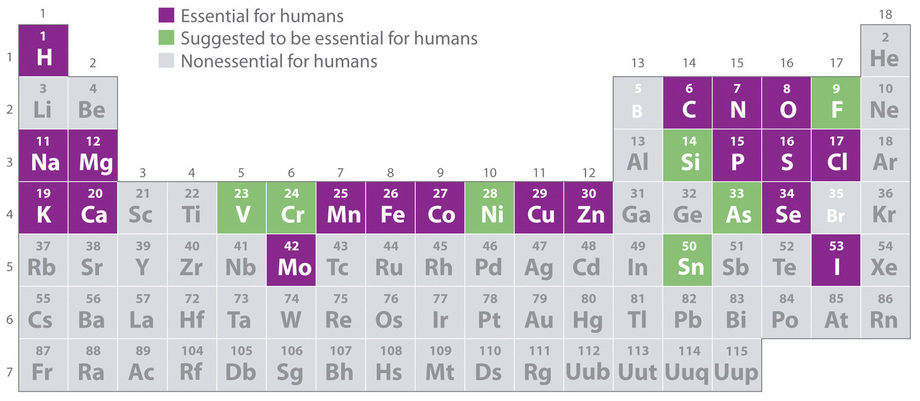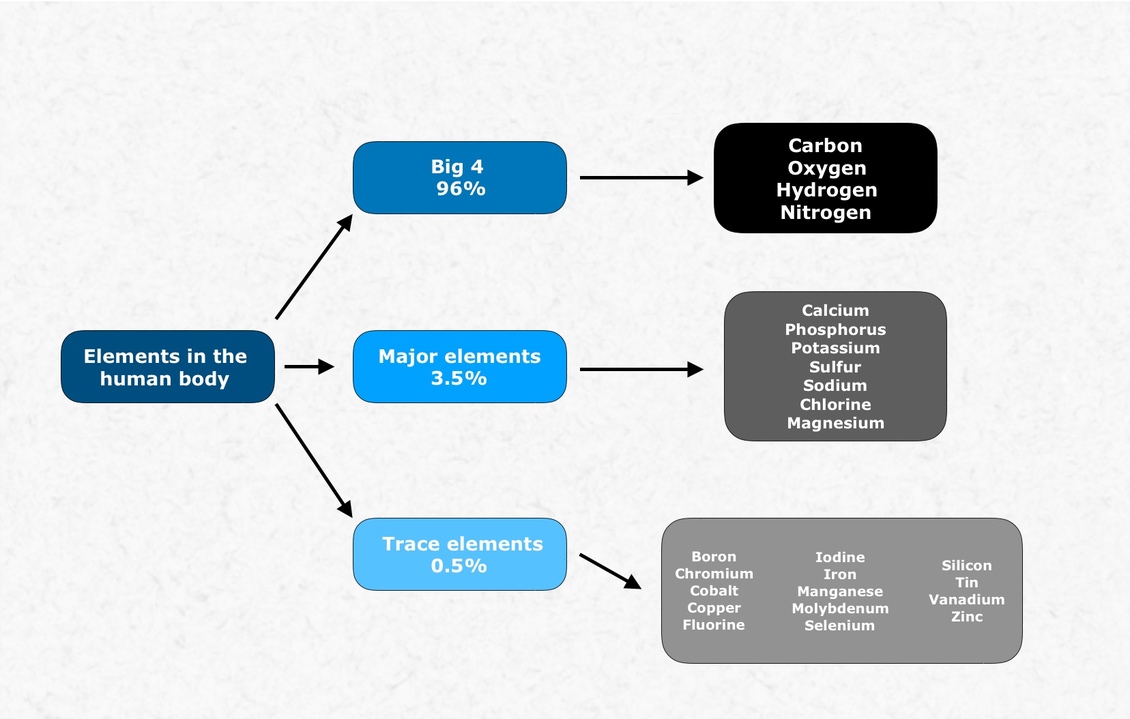https://en.wikipedia.org/wiki/Mineral_(nutrient)
Essential Elements for Life
Of the approximately 115 elements known, only the 19 highlighted in purple in Figure 1.8.11.8.1 are absolutely required in the human diet. These elements called essential elements are restricted to the first four rows of the periodic table, with only two or three exceptions (molybdenum, iodine, and possibly tin in the fifth row). Some other elements are essential for specific organisms. For example, boron is required for the growth of certain plants, bromine is widely distributed in marine organisms, and tungsten is necessary for some microorganisms.

How can elements toxic to life be essential? https://bre.is/3RHA7j1bH
___________________
What elements are present in the human body?
Scientists believe that about 25 of the known elements are essential to life. Just four of these – carbon (C), oxygen (O), hydrogen (H) and nitrogen (N) – make up about 96% of the human body.

https://www.sciencelearn.org.nz/resources/1728-the-essential-elements
A review on role of essential trace elements in health and disease
Elements are present in different forms in the nature, and these elements are very essential for the body to perform different functions.Trace elements are very important for cell functions at biological, chemical and molecular levels. These elements mediate vital biochemical reactions by acting as cofactors for many enzymes, as well as act as centers for stabilizing structures of enzymes and proteins. Some of the trace elements control important biological processes by binding to molecules on the receptor site of cell membrane or by alternating the structure of membrane to prevent entry of specific molecules into the cell. The functions of trace elements have a dual role. In normal levels, they are important for stabilization of the cellular structures, but in deficiency states may stimulate alternate pathways and cause diseases. These trace elements have clinical significance and these can be estimated using different analytical method.
___________________
Nutritional Aspects of Essential Trace Elements in Oral Health and Disease: An Extensive Review
Human body requires certain essential elements in small quantities and their absence or excess may result in severe malfunctioning of the body and even death in extreme cases because these essential trace elements directly influence the metabolic and physiologic processes of the organism. Rapid urbanization and economic development have resulted in drastic changes in diets with developing preference towards refined diet and nutritionally deprived junk food. Poor nutrition can lead to reduced immunity, augmented vulnerability to various oral and systemic diseases, impaired physical and mental growth, and reduced efficiency. Diet and nutrition affect oral health in a variety of ways with influence on craniofacial development and growth and maintenance of dental and oral soft tissues. Oral potentially malignant disorders (OPMD) are treated with antioxidants containing essential trace elements like selenium but even increased dietary intake of trace elements like copper could lead to oral submucous fibrosis. The deficiency or excess of other trace elements like iodine, iron, zinc, and so forth has a profound effect on the body and such conditions are often diagnosed through their early oral manifestations. This review appraises the biological functions of significant trace elements and their role in preservation of oral health and progression of various oral diseases.
https://www.ncbi.nlm.nih.gov/pmc/articles/PMC4940574/
___________________
Essential Trace Elements and Their Vital Roles in Human Body
Trace elements are naturally occurring inorganic substance required in humans in amounts <100 mg/day. They are essential components of biological structures and have an important effect on and play a key role in a variety of the processes necessary for life throughout mediate vital biochemical reactions. Excessive levels, a level higher than needed for biological functions, of these elements can be toxic for the body health. Therefore, it has been found that the imbalances in the optimum levels of trace elements may adversely affect biological processes and are associated with many fatal diseases, such as cancers. Recently, efforts have been focused to attempt to advance understand of the relationship between heavy metal, trace elements, and their role in cancers. Many studies indicated the remarkable of specific elements that may be of value and may have prognostic significance in the early diagnosis, prognosis, and therapy evaluation of some diseases, especially various types of cancer.
http://ijacskros.com/5%20Volume%203%20Issue/10.22607IJACS.2017.503003.pdf
___________________
ESSENTIAL TRACE ELEMENTS IN HUMAN HEALTH: A PHYSICIAN’S VIEW
Chemical elements in both free state and a variety of chemical compounds are included in all cells and tissues of the human body. They are the so-called “building blocks”, the most important catalysts for various biochemical reactions, the essential and indispensable participants in the processes of growth and development, metabolism, adaptation to changing environmental conditions [1]. Physiological effects of elements depend on their dose. Therefore, toxic elements (arsenic, mercury, antimony, cadmium etc.) in low concentrations can act in the body as a medicine (producing sanogenetic effect), whereas sodium, potassium, calcium, iron, magnesium, and some other elements in high concentrations can cause severe toxic effects.
___________________